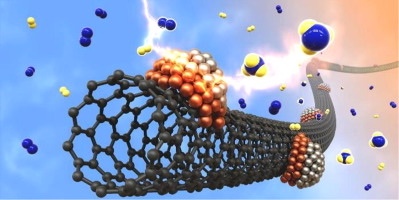

AIST: 51気圧・380℃でアンモニア合成!
Synthèse d’ammoniac à 51 atm 380°C !
Synthese von Ammoniak bei 51 atm 380°C!
Synthesis of ammonia at 51 atm 380°C!
在 51 atm 和 380°C 條件下合成氨
ー単層カーボンナノチューブに、ルテニウムを担持ー
ーハーバーボッシュ法より、エネルギー・コスト下げー
産業技術総合研究所:
「51気圧、380度Cでほぼ平衡濃度のアンモニアを製造できる触媒」を開発した。
単層カーボンナノチューブにルテニウムを担持する。
環境負荷の低いアンモニア合成につながる。
現行のハーバーボッシュ法:
- 400―600度Cの高温で、
- 100―300気圧の高圧で、
- アンモニアを合成する。
アンモニア製造触媒を新開発
消費エネルギーやコスト下げ窒素と水素を反応させてアンモニアを合成する。
単層カーボンナノチューブにセシウムを介して、ルテニウムの微粒子を固定した。
直径は2ナノメートル程度。
単層カーボンナノチューブ:
表面積が大きいため、高温でも微粒子が集合しにくく、活性点を保てる。
「380度C10気圧でのアンモニア合成」と、
「常温2気圧での停止を、7回繰り返し」しても、
活性は落ちなかった。
「380度C、51気圧で、平衡濃度に近い15%のアンモニア」が得られた。
発熱反応圧力を低減でき、消費エネルギーやコストを下げられる。
ニュースイッチ
AIST : Synthèse d’ammoniac à 51 atm et 380°C !
-Ruthénium supporté sur des nanotubes de carbone à paroi unique-
-Coûts énergétiques inférieurs à la méthode Haber-Bosch-
Institut national des sciences et technologies industrielles avancées :
Nous avons développé un “catalyseur capable de produire de l’ammoniac à une concentration proche de l’équilibre à 51 atmosphères et 380 degrés Celsius”.
Le ruthénium est supporté sur des nanotubes de carbone à paroi unique.
Cela conduit à la synthèse d’ammoniac avec un faible impact sur l’environnement.
Méthode Haber-Bosch actuelle :
À une température élevée de 400 à 600 degrés C,
À une haute pression de 100-300 atm,
Synthétiser l’ammoniac.
Catalyseur de production d’ammoniac nouvellement développé
Consommation d’énergie et réduction des coûts
L’ammoniac est synthétisé en faisant réagir de l’azote et de l’hydrogène.
Des microparticules de ruthénium ont été immobilisées sur des nanotubes de carbone à paroi unique via du césium.
Le diamètre est d’environ 2 nanomètres.
Nanotubes de carbone monoparoi :
Étant donné que la surface est grande, les particules fines sont moins susceptibles de s’agréger même à des températures élevées, et les sites actifs peuvent être maintenus.
“Synthèse d’ammoniac à 380 degrés C 10 atmosphères”,
Même si vous avez “répété l’arrêt à température ambiante 2 atm 7 fois”,
L’activité n’a pas baissé.
Une concentration proche de l’équilibre de 15 % d’ammoniac à 380 degrés C et 51 atmosphères a été obtenue.
La pression de réaction exothermique peut être réduite, ce qui réduit la consommation d’énergie et les coûts.
nouvel interrupteur
AIST: Synthese von Ammoniak bei 51 atm und 380°C!
-Ruthenium geträgert auf einwandigen Kohlenstoffnanoröhren-
-Geringere Energiekosten als bei der Haber-Bosch-Methode-
Nationales Institut für fortgeschrittene industrielle Wissenschaft und Technologie:
Wir haben einen “Katalysator entwickelt, der bei 51 Atmosphären und 380 Grad Celsius Ammoniak in nahezu gleichgewichtiger Konzentration erzeugen kann”.
Ruthenium wird auf einwandigen Kohlenstoffnanoröhren getragen.
Dies führt zu einer umweltschonenden Ammoniaksynthese.
Aktuelles Haber-Bosch-Verfahren:
Bei einer hohen Temperatur von 400-600 Grad C,
Bei einem Hochdruck von 100-300 atm,
Ammoniak synthetisieren.
Neu entwickelter Katalysator zur Herstellung von Ammoniak
Energieverbrauch und Kostenreduzierung
Ammoniak wird durch Reaktion von Stickstoff und Wasserstoff synthetisiert.
Ruthenium-Mikropartikel wurden über Cäsium auf einwandigen Kohlenstoffnanoröhren immobilisiert.
Der Durchmesser beträgt etwa 2 Nanometer.
Einwandige Kohlenstoffnanoröhren:
Da die Oberfläche groß ist, aggregieren feine Teilchen selbst bei hohen Temperaturen weniger wahrscheinlich, und aktive Stellen können aufrechterhalten werden.
“Ammoniaksynthese bei 380 Grad C 10 Atmosphären”,
Auch wenn Sie “den Stopp bei Raumtemperatur 2 atm 7 Mal wiederholt haben”,
Die Aktivität ist nicht gesunken.
Es wurde eine Konzentration nahe dem Gleichgewicht von 15 % Ammoniak bei 380 Grad C und 51 Atmosphären erhalten.
Der exotherme Reaktionsdruck kann reduziert werden, was den Energieverbrauch und die Kosten reduziert.
neuer Schalter
A super-growth carbon nanotubes-supported, Cs-promoted Ru catalyst for 0.1–8 MPaG ammonia synthesis
– ScienceDirect Abstract
For the decarbonization of ammonia industry, a super-growth carbon nanotube (SGCNT)-supported,
Cs-promoted Ru catalyst (Cs-Ru) was developed for mild ammonia synthesis (≤400 °C and ≤8 MPaG),
particularly under intermittent operation conditions.
This catalyst with well-dispersed Cs-promoted Ru particles
was superior to previously reported analogs in ammonia synthesis concerning activity and stability.
It produced ≈ 15 vol% of ammonia (rate ≈ 35 mmol g−1 h−1) at 380–400 °C and 5 MPaG (an H2/N2 molar ratio of 3 and a GHSV of 7000 h−1) that was close to thermodynamic equilibrium.
The active components of Cs-promoted Ru particles confined in the nanospace of SGCNTs facilitated the adsorption of hydrogen and nitrogen during the ammonia synthesis.
Hence,
it exhibited high resistance to hydrogen inhibition in H2-rich ammonia synthesis conditions,
particularly under pressurization, and facilitated nitrogen dissociation, resulting in high activity and stability in 0.1–8 MPaG ammonia synthesis at ≤400 °C.
https://www.sciencedirect.com/science/article/abs/pii/S0021951722003062